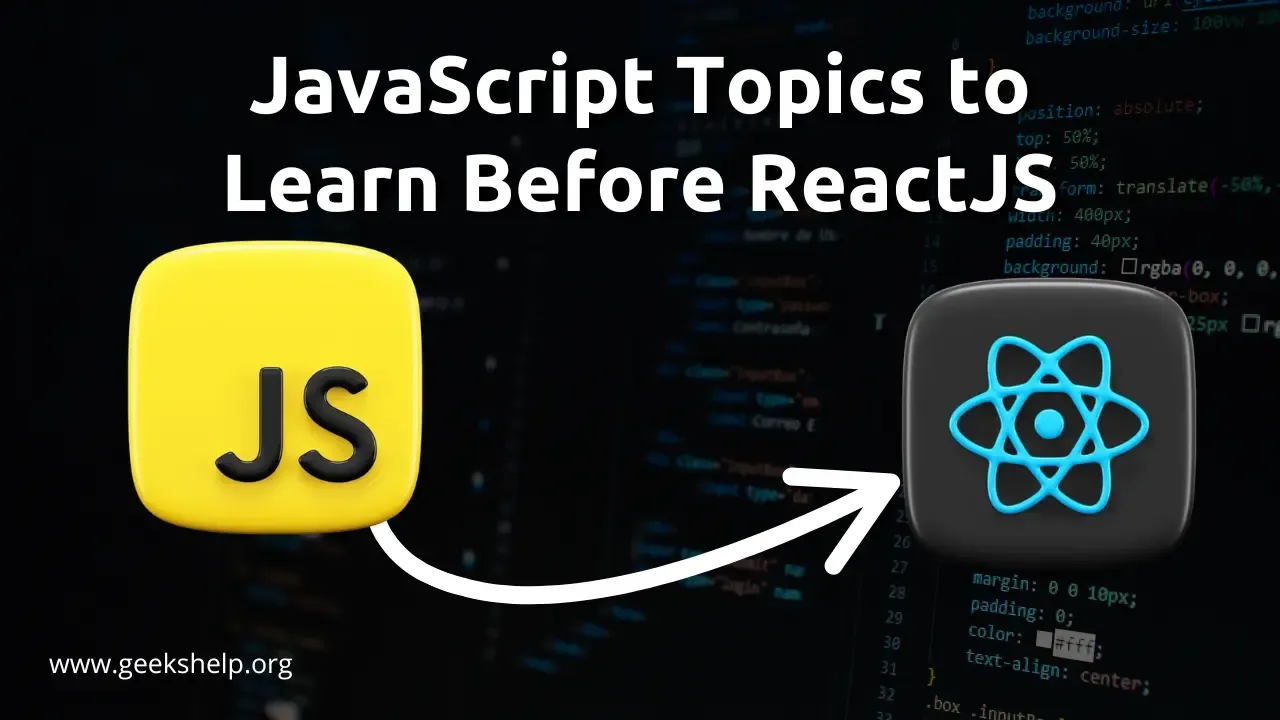If you're planning to learn ReactJS, laying a solid foundation in JavaScript is the smartest first step. At Geeks Help, we believe that mastering the fundamentals of JavaScript will not only ease your journey into React but also make you a more efficient and confident developer. This guide walks you through the essential JavaScript topics to understand before diving into ReactJS.

1. Variables and Data Types
Understanding how to declare variables using var, let, and const, and the differences between them is crucial. Familiarity with data types such as strings, numbers, booleans, arrays, and objects will help you manage state and props effectively in React.
2. Functions and Arrow Functions
React relies heavily on functional programming concepts.It's important to understand both traditional and arrow function syntax, as each has its place in modern JavaScript and React.
3. ES6+ Syntax
Modern JavaScript syntax, introduced with ES6 and beyond, is widely used in React. Key features to focus on include:
- Destructuring assignment
- Template literals
- Spread and rest operators
- Default parameters
- Enhanced object literals
- Optional chaining (?.) and nullish coalescing (??)
4. Arrays and Array Methods
React often involves working with lists of data. Understanding array methods like .map(), .filter(), .reduce(), .forEach(), and .find() is essential for rendering lists and transforming data.
5. Objects and Object Manipulation
Knowing how to access, modify, and clone objects is important when managing component state and props. React components frequently work with nested objects, so having a solid grasp on this topic is key.
6. DOM Manipulation
Even though React manages the DOM through its virtual layer, having a clear understanding of how the actual DOM functions—and how to modify it with plain JavaScript—can deepen your understanding of React’s behavior and make it easier to use external tools when required.
7. Event Handling
React has its own way of handling events, but the foundation is still rooted in JavaScript’s event model. Understanding how to work with event listeners and manage event propagation in plain JavaScript will help you adapt quickly to React’s synthetic events.
8. Asynchronous JavaScript (Promises, async/await)
APIs and data fetching are integral to modern web applications. You must be familiar with making asynchronous calls using fetch, handling promises, and using async/await to deal with asynchronous operations in React components.
9. Closures and Scope
Understanding closures, lexical scope, and variable hoisting helps in managing component state and writing efficient React hooks. Many subtle bugs in React arise due to a misunderstanding of closures and variable scope.
10. The this Keyword
Although less relevant in functional components, the this keyword is still important, especially when working with class components or older codebases. Knowing how this behaves in different contexts is helpful for debugging and maintenance.
11. Modules and Imports/Exports
React projects are modular by nature. You need to be comfortable with organizing code across multiple files and using import and export statements to share code between modules.
12. Error Handling and Debugging
Before working with a complex library like React, it’s important to be proficient at identifying and resolving bugs using try...catch, debugging tools, and browser developer consoles.
Final Thoughts from GeeksHelp
Learning ReactJS becomes significantly more manageable when you're already confident with JavaScript. At GeeksHelp, our mission is to guide aspiring developers from foundational skills to advanced frameworks with clarity and practical examples. Building a solid foundation in these JavaScript principles will give you the confidence and clarity to navigate React and grow as a front-end developer.
Stay tuned to GeeksHelp for more hands-on tutorials, real-world projects, and expert tips to level up your coding journey.



